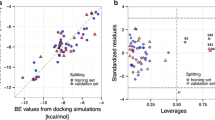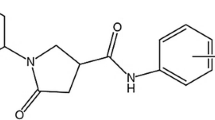Abstract
A model for computing the atomic compressibility (β) based on two periodic descriptors, namely, absolute radius (r) and atomic electrophilicity index (ω), is proposed as
The ansatz is invoked to compute compressibilities of atoms of 57 elements of the periodic table. The computed atomic data exhibits all sine qua non of periodic properties. Further, the concept group compressibility (Gβ) is also established invoking additivity property using some molecules with different functional groups and consequently utilized in correlating with molecular polarizability. Since toxicity prediction is an imperative need of the hour, chemical reactivity descriptors are of paramount importance in the study of toxicological behaviour along with a lot of other molecular reactivity studies within a Quantitative Structure–Activity Relationship (QSAR) context. Hence, this quantity is applied in the modelling of toxicological property through QSAR and a comprehensive study is performed in an effort to investigate and validate the application of compressibility in determining its toxicological power. Consequently, varied 209 organic molecules are selected for studying the toxic effect on Tetrahymena pyriformis. A QSAR model is constructed in terms of compressibility which offers a superior prediction of toxicity independently without adopting additional descriptors or properties as in some other QSAR studies.

Graphical abstract




Similar content being viewed by others
References
Bonin KD, Kresin VV (1997) Electric-dipole polarizabilities of atoms, Molecules and Clusters, World Scientific, Singapore
Connerade JP, Kengkan P, Lakshmi PA, Semaoune R (2000) Scaling laws for atomic compressibility. J Phys B Atomic Mol Phys 33:L847
Connerade JP, Semaoune R (2000) Atomic compressibility and reversible insertion of atoms into solids. J Phys B Atomic Mol Phys 33:3467
Chattaraj PK, Sarkar U (2003) Chemical reactivity of the spherically confined atoms. Chem Phys Lett 372:805–809
Noorizadeh S, Parhizgar M (2005) The atomic and group compressibility. J Mol Struct THEOCHEM 725:23–26
Chattaraj PK, Sengupta S (1996) Popular electronic structure principles in a dynamical context. J Phys Chem 100:16126–16130
Parr RG, Pearson RG (1983) Absolute hardness: companion parameter to absolute electronegativity. J Am Chem Soc 105:7512–7516
Donald KJ (2006) Electronic compressibility and polarizability: origins of a correlation. J Phys Chem A 110:2283–2289
Mullay J (1987) In: Sen KD, Jorgensen CK (eds) Structural bonding: electronegativity. Berlin, Springer-Verlag
Parr RG, Ayers PW, Nalewajski RF (2005) What is an atom in a molecule? J Phys Chem A 109:3957–3959
Chakraborty T, Gazi K, Ghosh DC (2010) Computation of the atomic radii through the conjoint action of the effective nuclear charge and the ionization energy. Mol Phys 108:2081–2092
Tandon H, Chakraborty T, Suhag V (2019) A new scale of electrophilicity index invoking force concept and its application in computing internuclear bond distance. Journal of Structural Chemistry (Accepted)
Fahrmeir L, Kneib T, Lang S, Marx B (2013) Regression: models, methods and applications, Springer Science & Buisness Media, Berlin, Heidelberg
Minitab 17 Statistical Software (2010) [Computer software] State College, PA: Minitab, Inc. (www.minitab.com)
Thole BT (1981) Molecular polarizabilities calculated with a modified dipole interaction. Chem Phys 59:3413–3450
Korchowiec J, Nalewajski RF (1992) Group electronegativity and Fukui function studies of the substituent effects in aromatic and inorganic systems. Int J Quantum Chem 44:1027–1040
Huheey JE (1965) The electronegativity of groups. J Phys Chem 69:3284–3291
Reed LH, Allen LC (1992) Bond polarity index: application to group electronegativity. J Phys Chem 96:157–164
Smith DW (1998) Group electronegativities from electronegativity equilibration applications to organic thermochemistry. J Chem Soc Faraday Trans 94:201–205
Van Lier G, Safi B, Geerlings P (1997) Acidity of substituted hydrofullerenes: an ab initio quantum-chemical study. J Phys Chem Solids 58:1719–1727
Langenaeker W, Demel K, Geerlings P (1991) Quantum-chemical study of the Fukui function as a reactivity index1: part 2. Electrophilic substitution on mono-substituted benzenes. Journal of Molecular Structure: THEOCHEM 234:329–342
De Proft F, Langenaeker W, Geerlings P (1993) Ab initio determination of substituent constants in a density functional theory formalism: calculation of intrinsic group electronegativity, hardness, and softness. J Phys Chem 97:1826–1831
De Proft F, Amira S, Choho K, Geerlings P (1994) Quantum-chemical study of the acidity of substituted acetic acids with density functional theory based descriptors. J Phys Chem 98:5227–5233
De Proft F, Langenaeker W, Geerlings P (1995) Acidity of first-and second-row hydrides: effects of electronegativity and hardness. Int J Quantum Chem 55:459–468
De Proft F, Langenaeker W, Geerlings P (1995) Acidity of alkyl substituted alcohols: are alkyl groups electron-donating or electron-withdrawing? Tetrahedron. 51:4021–4032
Krishnamurty S, Pal S (2000) Intermolecular reactivity trends using the concept of group softness. J Phys Chem A 104:7639–7645
Pérez P, Toro-Labbé A (2000) Characterization of keto-enol tautomerism of acetyl derivatives from the analysis of energy, chemical potential, and hardness. J Phys Chem A 104:1557–1562
Jaque P, Toro-Labbe A (2000) Theoretical study of the double proton transfer in the CHX− XH⊙⊙⊙ CHX− XH (X= O, S) complexes. J Phys Chem A 104:995–1003
Cárdenas-Jirón GI, Toro-Labbé A (1997) Fragment chemistry of the hydrogen thioperoxide molecule; energy, chemical potential and hardness. J Mol Struct THEOCHEM 390:79–89
Van Duijnen PT, Swart M (1998) Molecular and atomic polarizabilities: Thole’s model revisited. J Phys Chem A 102:2399–2407
Mekenyan OG, Veith GD (1993) Relationships between descriptors for hydrophobicity and soft electrophilicity in predicting toxicity. SAR QSAR Environ Res 1:335–344
Comporti M (1989) Three models of free radical-induced cell injury. Chem Biol Interact 72:1–56
Mikolajczyk A, Gajewicz A, Rasulev B, Schaeublin N, Maurer-Gardner E, Hussain S, Leszczynski J, Puzyn T (2015) Zeta potential for metal oxide nanoparticles: a predictive model developed by a nano-quantitative structure–property relationship approach. Chem Mater 27:2400–2407
Mikolajczyk A, Sizochenko N, Mulkiewicz E, Malankowska A, Nischk M, Jurczak P, Hirano S, Nowaczyk G, Zaleska-Medynska A, Leszczynski J, Gajewicz A (2017) Evaluating the toxicity of TiO2-based nanoparticles to Chinese hamster ovary cells and Escherichia coli: a complementary experimental and computational approach. Beilstein J Nanotechnol 8:2171–2180
Mikolajczyk A, Gajewicz A, Mulkiewicz E, Rasulev B, Marchelek M, Diak M, Hirano S, Zaleska-Medynska A, Puzyn T (2018) Nano-QSAR modeling for ecosafe design of heterogeneous TiO 2-based nano-photocatalysts. Environ Sci Nano 5:1150–1160
Mikolajczyk A, Sizochenko N, Mulkiewicz E, Malankowska A, Rasulev B, Puzyn T (2019) A chemoinformatics approach for characterization of hybrid nanomaterials: safer and efficient design perspective. Nanoscale 11:1808–11818
Shalini A, Tandon H, Chakraborty T (2017) Molecular electrophilicity index - A promising descriptor for predicting toxicological property. J Bioequiv Availab 9:518–527
Singh PP, Srivastava HK, Pasha FA (2004) DFT-based QSAR study of testosterone and its derivatives. Bioorg Med Chem 12:171–177
Pasha FA, Srivastava HK, Singh PP (2005) Comparative QSAR study of phenol derivatives with the help of density functional theory. Bioorg Med Chem 13:6823–6829
Srivastava HK, Pasha FA, Singh PP (2005) Atomic softness-based QSAR study of testosterone. Int J Quantum Chem 103:237–245
Chakraborty T, Ghosh DC (2013) Correlation of the drug activities of some anti-tubercular chalcone derivatives in terms of the quantum mechanical reactivity descriptors. In: Haghi AK (ed) Methodologies and applications for chemoinformatics and chemical engineering. IGI Global, Hershey, PA, pp 155–168
Parr RG, Yang W (1989) Density functional theory of atoms and molecules. Oxford University Press, New York
Mikolajczyk A, Malankowska A, Nowaczyk G, Gajewicz A, Hirano S, Jurga S, Zaleska-Medynska A, Puzyn T (2016) Combined experimental and computational approach to developing efficient photocatalysts based on Au/Pd-TiO2 nanoparticles. Environ Sci Nano 3:1425–1435
Chermette H (1999) Chemical reactivity indexes in density functional theory. J Comput Chem 20:129–154
Geerlings P, De Proft F, Langenaeker W (2003) Conceptual density functional theory. Chem Rev 103:1793–1874
Chattaraj PK, Nath S, Maiti B (2004) Reactivity descriptors. In: Bultinck P, Winter HD, Langenaeker W, Tollenaere JP (eds) Computational medicinal chemistry for drug discovery. Marcel Dekker, New York, USA, pp 295–322
Parr RG (1983) Density functional theory. Annu Rev Phys Chem 34:631–656
Chattaraj PK, Maiti B, Sarkar U (2003) Philicity: a unified treatment of chemical reactivity and selectivity. J Phys Chem A 107:4973–4975
Chattaraj PK, Roy DR (2005) Local descriptors around a transition state: a link between chemical bonding and reactivity. J Phys Chem A 109:3771–3772
Tandon H, Chakraborty T, Suhag V (2019) A new model of atomic nucleophilicity index and its application in the field of QSAR. International Journal of Quantitative Structure-Property Relationships 4:99–117
Tandon H, Shalini, Ranjan P, Suhag V, Chakraborty T (2019) A review of a computational study of carbon nanotubes. In: Vakhrushev AV, Kodolov VI, Haghi AK, Ameta SC (eds) Carbon nanotubes and nanoparticles: current and potential applications. Apple Academic Press, Toronto; New Jersey, pp 25–38
Thanikaivelan P, Subramanian V, Rao JR, Nair BU (2000) Application of quantum chemical descriptor in quantitative structure activity and structure property relationship. Chem Phys Lett 323:59–70
Parthasarathi R, Subramanian V, Roy DR, Chattaraj PK (2004) Electrophilicity index as a possible descriptor of biological activity. Bioorg Med Chem 12:5533–5543
Roy DR, Sarkar U, Chattaraj PK, Mitra A, Padmanabhan J, Parthasarathi R, Subramanian V, Van Damme S, Bultinck P (2006) Analyzing toxicity through electrophilicity. Mol Divers 10:119–131
Akers KS, Sinks GD, Schultz TW (1999) Structure–toxicity relationships for selected halogenated aliphatic chemicals. Environ Toxicol Pharmacol 7:33–39
Schultz TW (1997) TETRATOX: Tetrahymena pyriformis population growth impairment endpointa surrogate for fish lethality. Toxicology methods 7:289–309
Dimitrov SD, Mekenyan OG, Sinks GD, Schultz TW (2003) Global modeling of narcotic chemicals: ciliate and fish toxicity. J Mol Struct THEOCHEM 622:63–70
Roy DR, Parthasarathi R, Maiti B, Subramanian V, Chattaraj PK (2005) Electrophilicity as a possible descriptor for toxicity prediction. Bioorg Med Chem 13:3405–3412
SAS Institute Inc. (1989) SAS/STAT® user’s guide, version 6 (4th edition), Volume 2, Cary NC: SAS Institute Inc.
Finney DJ (1971) Probit analysis. Cambridge University Press, Cambridge, UK
Bridgman PW (1926) The five alkali metals under high pressure. Phys Rev 27:68–86
Grosse AV (1964) The compressibility of solid noble gases and the alkali metals at 0° K. J Inorg Nucl Chem 26:1801–1809
Smeyers YG, Bouniam L, Smeyers NJ, Ezzamarty A, Hernandez-Laguna A, Sainz-Diaz CI (1998) Quantum mechanical and QSAR study of some α-arylpropionic acids as anti-inflammatory agents. Eur J Med Chem 33:103–112
Karabunarliev S, Mekenyan OG, Karcher W, Russom CL, Bradbury SP (1996) Quantum-chemical descriptors for estimating the acute toxicity of electrophiles to the fathed minnow (Pimephales promelas): an analysis based on molecular mechanisms. Quant Struct Act Relat 15:302–310
Lipnick RL (1991) Outliers: their origin and use in the classification of molecular mechanisms of toxicity. Sci Total Environ 109:131–153
Gawley RE (1976) The Robinson annelation and related reactions. Synthesis 1976:777–794
Netzeva TI, Schultz TW, Aptula AO, Cronin MT (2003) Partial least squares modelling of the acute toxicity of aliphatic compounds to Tetrahymena pyriformis. SAR QSAR Environ Res 14:265–283
Schultz TW, Cronin MT, Netzeva TI, Aptula AO (2002) Structure–toxicity relationships for aliphatic chemicals evaluated with tetrahymena pyriformis. Chem Res Toxicol 15:1602–1609
Toropov AA, Benfenati E (2004) QSAR modelling of aldehyde toxicity against a protozoan, Tetrahymena pyriformis by optimization of correlation weights of nearest neighboring codes. J Mol Struct THEOCHEM 679:225–228
Castro EA, Toropov AA, Nesterova AI, Nazarov AU (2003) QSAR study of the toxic action of aliphatic compounds to the bacteria Vibrio fisheri based on correlation weighting of local graph invariants. J Mol Struct THEOCHEM 639:129–135
Acknowledgements
The authors are thankful to Manipal University Jaipur for providing computational and research facility.
Author information
Authors and Affiliations
Corresponding author
Ethics declarations
Conflict of interest
The authors declare that they have no conflict of interest.
Additional information
Publisher’s note
Springer Nature remains neutral with regard to jurisdictional claims in published maps and institutional affiliations.
Rights and permissions
About this article
Cite this article
Tandon, H., Chakraborty, T. & Suhag, V. A model of atomic compressibility and its application in QSAR domain for toxicological property prediction. J Mol Model 25, 303 (2019). https://doi.org/10.1007/s00894-019-4199-9
Received:
Accepted:
Published:
DOI: https://doi.org/10.1007/s00894-019-4199-9




